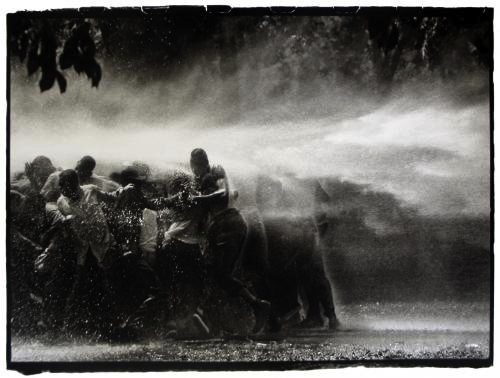
Bob Adelman. “No Man Is An Island, Kelly Ingram Park, Birmingham, Alabama,” 1963. Gelatin silver print; printed later. 30 x 40 in. Edition of 15.
Recent images from Istanbul’s Taksim Square may remind some Americans of the Civil Rights Movement, particularly those photographs of huddled protesters absorbing the force of pressurized water directed by firemen sent not to rescue but rebuke. Now fifty years later, two splendid photographic surveys at Howard Greenberg Gallery: 1963 and Bruce Davidson: Time of Change: Civil Rights Photographs, 1961-1965, seems well timed, even mildly prophetic, given the demonstrations and court proceedings of the last few weeks.
In the group show, black-and-white photographs by Bob Adelman, Dennis Hopper, Carl Mydans, Gordon Parks, and other notables show us just how critical 1963 was: Martin Luther King, Jr. delivered his “I Have a Dream” speech on the steps of the Lincoln Memorial; John F. Kennedy and Medgar Evers were assassinated; the Vietnam War was escalating; and newspaper reporters, gripped by the piercing screams of teenage girls, officially declared “Beatlemania.” This was a year when, as the press release says, “everything changed.” 1963 shrilly conveys this time of turbulence and celebrity, from the pulling of triggers to the plucking of guitar strings.
This modestly-sized Midtown gallery affords the pleasure of intimacy with prints by some of the twentieth century’s most renowned photographers. The work of Bruce Davidson, is included in both the group survey and a solo show, Time of Change, focusing on his Civil Rights photographs taken between 1961 and 1965. I failed to notice where 1963 ended and Time of Change began—that is a compliment to the curator. Davidson’s photographs of children are especially penetrating. A young African American girl, draped in a transparent poncho, stands angelically before a barbed wire fence. In another photo, she walks down a rural road in a procession, presumably on the march from Selma to Montgomery, Alabama, with Martin Luther King, Jr. at the head. But there is something dark and body bag-like about her poncho set against the southern landscape, suggesting the risk this generation—and its photographers—endured.
What these shows affirm is that one action, be it brave or cruel, can completely transform the lives of many. And while legal injustices still exist, 2013 is not 1963 and for that we can be thankful.
1963 and Time of Change are on view at Howard Greenberg Gallery in New York through July 6, 2013.



